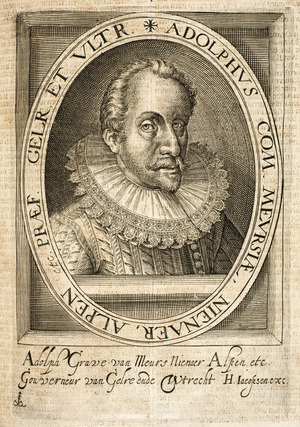Adolf van Nieuwenaar facts for kids
Quick facts for kids
Adolf van Nieuwenaar
|
|
|---|---|

Adolf von Neuenahr, 1545-1589
|
|
| Born | c. 1545 |
| Died | October 18, 1589 (aged 43–44) |
Adolf van Nieuwenaar, Count of Limburg and Moers (also known as Adolf von Neuenahr) was an important leader and soldier. He was born around 1545 and died on October 18, 1589. Adolf served as a stadtholder (a type of governor or leader) for several regions in the Netherlands. These regions included Overijssel, Guelders, and Utrecht. He played a role in the Eighty Years' War, which was a long conflict where the Dutch fought for their independence.
Early Life and Family
Adolf van Nieuwenaar, often called Nieuwenaar, was born to Count Gumprecht II von Neuenahr-Alpen and Amöna von Daun. After his father passed away in 1556, Adolf was raised by his uncle, Count Hermann of Neuenahr and Moers. Hermann was a Protestant and was married to Magdalene, who was a half-sister of William the Silent, a very famous Dutch leader.
In 1570, Adolf married his aunt, Walburgis van Nieuwenaer. She was the widow of Philip de Montmorency, Count of Hoorn, who had been executed by the Duke of Alba in 1568. When his uncle Hermann died in 1578 without children, Nieuwenaar inherited his lands, including the area called Moers. These lands were located near the modern border between Germany and the Netherlands.
Fighting in the Cologne War
Nieuwenaar was involved in a conflict known as the Cologne War. This war started because Gebhard Truchsess von Waldburg, who was a Prince-elector and Archbishop in Cologne, decided to get married and change his religion to Calvinism. This was unusual for an Archbishop.
In 1583, the Pope removed Gebhard from his position. A new Elector, Ernest of Bavaria, was chosen. This led to a war between Gebhard and Ernest. Nieuwenaar supported Gebhard as his general, along with Dutch rebels. Ernest was supported by his brothers and eventually by Spain. By 1586, Nieuwenaar lost control of all his lands in Germany because of this war.
Becoming a Stadtholder
After losing his German lands, Nieuwenaar found a new role in the rebellious Netherlands. The previous stadtholder of Gelderland, Willem IV van den Bergh, was removed from his position in 1583. This happened because he was found to be secretly working with the Spanish leader, Alexander Farnese, Duke of Parma. Nieuwenaar was then chosen as the new stadtholder for Gelderland. However, at first, he only controlled the city of Arnhem and the areas around it, as most of the province was held by the Spanish.
In 1584, Nieuwenaar's uncle, William the Silent, was sadly assassinated. William was also the stadtholder of Utrecht and Overijssel. After some time, the Dutch government appointed Nieuwenaar to take his uncle's place as stadtholder for these provinces too.
In Utrecht, there was a political disagreement between different groups. Robert Dudley, 1st Earl of Leicester, who became the new Governor-General for the Dutch side in 1585, supported one of these groups, and Nieuwenaar did too. But after Leicester left in 1587, Nieuwenaar slowly changed his mind. He helped bring the groups to a peaceful agreement. In 1588, one of the groups was removed from power in Utrecht, but Nieuwenaar kept his position as stadtholder.
As a stadtholder, Nieuwenaar was also in charge of the military forces in his provinces. He led several military actions, but they were not always successful. He captured the city of Neuss in 1585, but it was soon lost to Spain again. During a retreat in 1586, Nieuwenaar destroyed Kamp Abbey. In 1585, a Spanish general defeated Nieuwenaar and Maarten Schenk van Nydeggen at the Battle of Amerongen. Later that year, Schenk built a fortress called Schenkenschans under Nieuwenaar's orders.
Adolf van Nieuwenaar died in Arnhem on October 18, 1589. He was testing a new type of cannon when it exploded.
See also
 In Spanish: Adolf van Nieuwenaar para niños
In Spanish: Adolf van Nieuwenaar para niños


